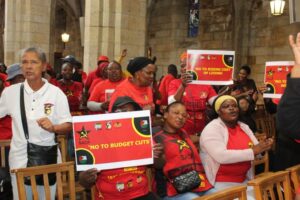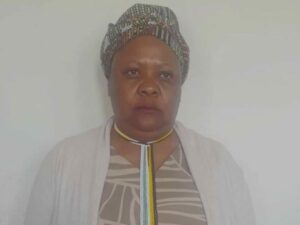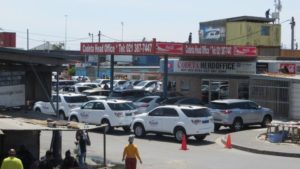21 days since the collapse of one of four dams on the Dassenberg Farm in Riverlands, the Department of Water and Sanitation (DWS) launched a preliminary report into the cause of the disaster which devastated the community of Riverlands in the Western Cape and left dozens of people homeless.
The report reveals that the Dassenberg Farm dams are not registered with the DWS and are therefore unlicenced. Three of the four dams were constructed in the 1960s and the largest dam on the property was built in July 2005. Dassenberg Farm was, according to the report, sold to Agrico Machinery who built the fourth dam without the necessary permit.
The farm and the dams
are owned by the
Department of Agriculture
The farm is now owned by the Department of Agriculture, Land Reform and Rural Development (DALRRD) which, according to the DWS Minister, Pemmy Majodina, acquired the farm in 2019 and is currently leasing it to Mazibuyinkomo Primary Agricultural Co-operative.
The dams had no sufficient spillways which caused them to break as it was raining heavily. “Initial information suggested that Dam 3 filled beyond the safe level resulting in overtopping due to high rainfall and associated run-off causing Dam 2 and Dam 1 to fail in the series,” said Majodina, delivering the findings of the report at Riverlands Primary on Thursday.
The report will be shared will all implicated government departments but the minister could not say when they would respond, only that they will hav eto do so within 14 days. “We are calling on everyone to abide by the law. You cannot just wake up and decide to construct a dam,” she said. “We want all the departments concerned to respond to us, within 14 days,” she said.
Minister of Water and Sanitation, Pemmy Majodina during the opening of parliament this year.
The department of agriculture had failed to take due diligence by ensuring that the dams were registered when it took over the farm. Majodina said the current and previous owners have to answer for the disaster that affected hundreds of people, leaving some homeless, and causing severe damage to infrastructure ,including roads, railway lines, and Eskom’s transmission network.
‘The agriculture department
must present a
rehabilitation plan’
The minister announced that the DWS would, together with the Swartland Municipality, determine the extent of the damage caused by the failure of the dams, and provide compensation for the rebuilding of infrastructure. “The DALRRD must present a rehabilitation plan for the affected areas caused by the failure of Dassenberg Farm dams,” and implement it, she added. The rebuilding of homes that were destroyed, she said , was not her department as they are not mandated to build houses. “The Department of Human Settlements and the municipality must do the assessment and inform us afterwards.”
Mayor of Swartland Municipality, Harold Cleophas told reporters and community members that they estimate the damage to be around R50-million.
Struggle to rebuild
The residents who spoke to Elitsha said it will take a very long time for them to pick up the pieces and get their lives together again. Community leader and longtime resident of Riverlands, Ralf Burger said, “The disaster has affected every aspect of our lives and residents of this place. We cannot do sports, businesses are stuck, we cannot even look after ourselves. We are people who pride ourselves on being independent and not being anyone’s burden. Our livelihood has been wiped out. Our rugby field has been badly damaged, and our team plays in the higher league. They cannot train now and don’t even have an alternative field. Business people have lost their markets,” said Burger.
‘Not having water
is the greatest problem’
He said they want the government to give them a timeline of when certain help will be provided. “We are still sitting in the dark now, because they didn’t bring us a clear plan of how they are going to help us. Not having water is the greatest problem. … The free water tankers did not come for the day. You can only have so much water just to drink which is stored in small buckets. Those with small children and living with elderly people are suffering the most,” said Burger.
He said, they have sent a cry for help to certain companies to assist with providing water.
Some community members not only lost their homes but their livelihoods as well.
‘People were in their beds
floating on the water
and crying for help.
Children were hanging
on tree branches. ‘
Donovan Manuel (50) says, the flood happened at night and it was unexpected. “It was around 3 a.m. in the morning. It swept away everything. People were in their beds floating on the water and crying for help. Children were hanging on tree branches. The community saved themselves and reached out to each other. I have lost my life actually and everything that I have built over these years. I was someone who would go into the bushes and collect wood, and then sell it to people to sustain my family,” said Manuel.
He said his machinery and tools were washed away. “It’s a concern for me. I don’t know how I will take care of myself. I strongly believe, those responsible for this disaster should reimburse us. We are not satisfied with the pace at which the municipality is attending to this situation. They have ways in which they can fast-track the help to us. Currently I am not making a living for myself and we live in a shelter. I don’t know what is the way forward, unless they can come back and assist us to get back on our feet,” he appealed.
When Elitsha took a walk to some of the informal settlements that were damaged by the flash floods, we crossed what was once a road, washed away by the flood. Damaged cupboards and household items, washing machines and clothing lay strewn outside the fallen walls of homes. Jim Forster (57), a small-scale farmer from Riverlands, had his home damaged by the floods and lost his livestock as well. Except for a few chickens that survived the floods, he is left with a broken foundation of their home and a dilapidated home clinging to the earth.
On Thursday, he showed Elitsha a large structure for chicken farming that he was building with bricks with the help of his son; it had also crumbled to the ground. “I have lost a lot in this disaster. I don’t have a home at all and our livelihood is all gone. All that I have worked for the past thirty two years of staying here has been washed away with the floods. I don’t know how we are going to recover from this. We have to start from the bottom.
Report recommendations
Some of the recommendations that have been made by the DWS report include that, the DALRRD ,as the dam owner, must inform the DWS whether it intends to repair the dams or to decommission the them. Should they decide to rebuild the dams, it must apply to DWS for a water-use license and a dam safety license.
The report has also recommended that the Swartland Local Municipality, conducts a stormwater management assessment to investigate the current and future impact that the Swart River will have on the residents of the town of Riverland, in the absence of any flood retention which was provided by the Dassenberg Farm dams.





